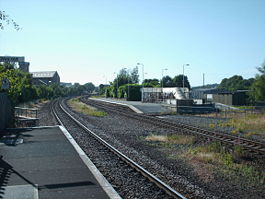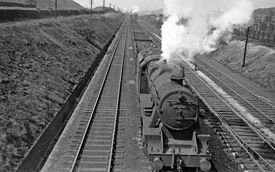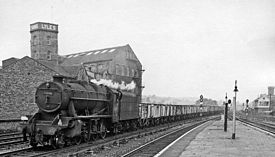- Mirfield railway station
-
Mirfield 

The view from platform 3 Location Place Mirfield Local authority Kirklees Coordinates 53°40′18″N 1°41′36″W / 53.6716°N 1.6933°WCoordinates: 53°40′18″N 1°41′36″W / 53.6716°N 1.6933°W Grid reference SE203195 Operations Station code MIR Managed by Northern Rail Number of platforms 3 Live arrivals/departures and station information
from National Rail EnquiriesAnnual rail passenger usage 2004/05 * 0.134 million 2005/06 *  0.149 million
0.149 million2006/07 *  0.169 million
0.169 million2007/08 *  0.185 million
0.185 million2008/09 *  0.260 million
0.260 million2009/10 *  0.281 million
0.281 millionPassenger Transport Executive PTE West Yorkshire (Metro) Zone 3 History Opened 1845 History Original company Manchester and Leeds Railway Pre-grouping Lancashire and Yorkshire Railway Post-grouping London, Midland and Scottish Railway National Rail - UK railway stations A B C D E F G H I J K L M N O P Q R S T U V W X Y Z * Annual passenger usage based on sales of tickets in stated financial year(s) which end or originate at Mirfield from Office of Rail Regulation statistics. Please note: methodology may vary year on year. Mirfield railway station serves the town of Mirfield in West Yorkshire, England. It lies on the Huddersfield Line operated by Northern Rail and is 4 miles (6 km) north east from Huddersfield.
The platforms have an unusual configuration. Platforms 1 and 2 form an island platform on the western side of the bridge over Station Road/Hopton New Road. Trains from Platform 1 go to Leeds and Wakefield Westgate (eastbound); Platform 2 is rarely used for normal scheduled services but is passed by non-stopping westbound trains to Huddersfield. Platform 3 is a side platform on the eastern side of the bridge; trains are towards Huddersfield, Halifax, Bradford Interchange and Brighouse (westbound). The train to Leeds takes around 25 minutes and to reach Huddersfield takes around 10 minutes.
Contents
History
The town received its first railway in 1840, when the Manchester and Leeds Railway opened the first section of its cross-Pennine main line between Normanton and Hebden Bridge (completing it through to Manchester on 1 March 1841). It did not actually get a station though until April 1845,[1] when the company opened one shortly before submitting plans to Parliament to build a branch line from the town along the Spen Valley to Bradford via Cleckheaton. Approval was granted for the route the following year and it was opened as far as Low Moor on 12 July 1848 and through to Bradford two years later. By this time further lines had been opened from nearby Heaton Lodge Junction to Huddersfield by the Huddersfield & Manchester Railway (opened on 3 August 1847) and from Thornhill to Leeds by the Leeds, Dewsbury & Manchester Railway (opened 18 September 1848).[2] The LNWR (which had absorbed both the H&M and LD&M by 1849) had originally planned to build its own route through Mirfield, but after negotiations with the Lancashire and Yorkshire Railway (successors to the M&L) agreed to not to go ahead in return for the granting of running powers over the Thornhill to Heaton Lodge section (and also allowing the L&Y access to Huddersfield). This meant that the railway passing through the town soon became extremely congested, carrying as it did the traffic on two main trunk routes between Manchester and Leeds (the Huddersfield & Manchester company having completed its route through Stalybridge in August 1849) and it led to the station gaining a notorious reputation for delays. This persisted even after the Heaton Lodge - Thornhill section was quadrupled in 1884,[3] and it was not until the LNWR opened an alternative Huddersfield to Leeds route at the turn of the century that the situation began to improve.
Today the station remains busy, despite the loss of the Spen Valley service to Bradford from 14 June 1965[4] and the links to Normanton and York on 5 January 1970 (the line via Brighouse also closed at the same time, but this reopened in 2000 for peak hour services). It has also lost its buildings to demolition (in the late 1970s) and one of its four tracks but gained the aforementioned third platform as part of a set of capacity improvements in the late 1980s.
Services
Eastbound from Mirfield, two trains per hour (approximately half-hourly) operate on weekdays and Saturdays towards Leeds, with an hourly service to Wakefield Westgate via Wakefield Kirkgate.
Westbound two trains an hour serve Huddersfield, one continuing to Halifax and Bradford Interchange, with connecting services at Huddersfield to Manchester centre and Manchester Airport. There is also an hourly daytime service to Manchester Victoria via Brighouse and Hebden Bridge - this was introduced as part of the December 2008 timetable alterations on the Caldervale Line. During the weekday morning peak an additional train runs to Leeds.
On Sundays, a two-hourly service operates to Leeds and Huddersfield. There are no Sunday services to Wakefield or Hebden Bridge/Manchester.
Notes
References
- Bairstow, M. (1983), The Manchester & Leeds Railway (The Calder Valley Line), Wyvern Publishing, Skipton, ISBN 0-90794-106-0
- Body, G. (1988), PSL Field Guides - Railways of the Eastern Region Volume 2, Patrick Stephens Ltd, Wellingborough, ISBN 1-85260-072-1
External links
- Train times and station information for Mirfield railway station from National Rail
Preceding station  National Rail
National RailFollowing station Northern Rail Railways in North Kirklees (Past, present and future) Legend


To Bradford Birstall Town 






To Leeds Gomersal 






Howden Clough Lower Birstall 






Upper Batley 






To Leeds Carlinghow 




















To Bradford 






To Leeds Cleckheaton Central 






Cleckheaton Spen 






Batley Liversedge Central 






Liversedge Spen 






Chickenley Heath Heckmondwike Central 






Heckmondwike Spen Batley Carr 






To Wakefield 






Staincliffe and Batley Carr 






Dewsbury Central 













Earlsheaton 






To Wakefield Dewsbury Wellington Road 






Ravensthorpe Lower 






Dewsbury Market Place Northorpe Higher 






Northorpe North Road 






To Wakefield Ravensthorpe 






Dewsbury Midland Goods Battyeford 






Thornhill Mirfield 






To Royston and Notton To Huddersfield 






To Huddersfield Railway stations in West Yorkshire MetroTrain lines ■ Airedale · ■ Caldervale · ■ Dearne Valley · ■ Hallam · ■ Harrogate · ■ Huddersfield · ■ Leeds-Bradford · ■ Penistone · ■ Pontefract · ■ Wakefield · ■ Wharfedale · ■ York & Selby
City of Bradford Calderdale Kirklees Batley · Berry Brow · Brockholes · Deighton · Denby Dale · Dewsbury · Honley · Huddersfield · Lockwood · Marsden · Mirfield · Ravensthorpe · Shepley · Slaithwaite · StocksmoorCity of Leeds Bramley · Burley Park · Cottingley · Cross Gates · East Garforth · Garforth · Guiseley · Headingley · Horsforth · Leeds · Micklefield · Morley · New Pudsey · WoodlesfordCity of Wakefield Outside West Yorkshire,
but within the
West Yorkshire Metro areaCategories:- Railway stations in Kirklees
- Former Lancashire and Yorkshire Railway stations
- Railway stations served by Northern Rail
- DfT Category F1 stations
Wikimedia Foundation. 2010.


